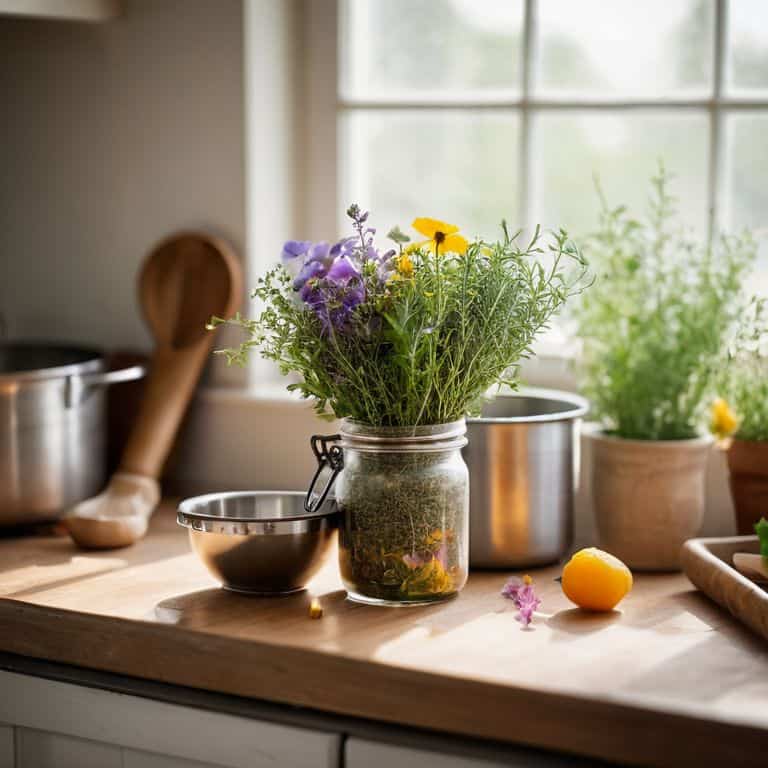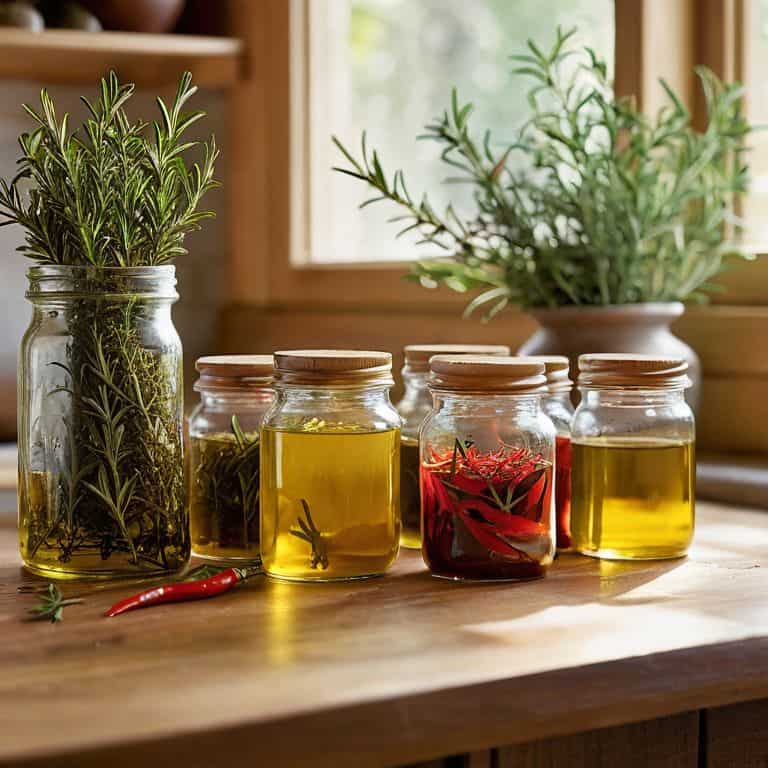I still remember the first time I stumbled upon the world of infusions – it was like unlocking a secret flavor bomb in my kitchen. I was experimenting with how to make infusions for my craft cocktail bar, and let me tell you, it was a game-changer. The common myth that infusions are only for fancy-pants bartenders or that they require a tedious, complicated process is just that – a myth. In reality, making infusions is ridiculously easy and accessible to anyone willing to get their hands dirty.
So, what if I told you that you could create your own signature infusions at home, using nothing but fresh ingredients and a bit of patience? In this article, I’ll share my no-nonsense approach to how to make infusions, from the basics of choosing the right ingredients to the tips and tricks for experimenting with unique flavor combinations. You’ll learn how to unleash the magic of homemade infusions, one fresh ingredient at a time, and discover a world of flavors that will elevate your cooking and cocktail game to the next level. Get ready to join me on this flavorful journey and start creating your own infusions that will make your taste buds dance!
Table of Contents
Guide Overview: What You'll Need

Total Time: 30 minutes to 1 hour
Estimated Cost: $10 – $30
Difficulty Level: Easy
Tools Required
- Tea Infuser (optional)
- Mason Jar (with lid)
- Spoon (for measuring)
- Cheesecloth (or a coffee filter)
Supplies & Materials
- Dried Herbs (such as chamomile or peppermint)
- Fresh Fruits (such as lemons or berries)
- Vodka (or other neutral spirit)
- Honey (optional, for sweetening)
Step-by-Step Instructions
- 1. First, let’s start by gathering our ingredients and equipment – we’ll need some fresh herbs, a clean glass jar, and a lid to get our infusion game on. I like to use a mix of herbs like mint, basil, and lemongrass for a refreshing flavor, but feel free to experiment with whatever you have on hand. The key is to have fun and get creative with your combinations.
- 2. Next, give your herbs a good rinse and pat them dry with a paper towel to remove any excess moisture. This step is crucial to prevent any bacterial growth in your infusion, and trust me, you don’t want that. I’ve learned this the hard way, and it’s not pretty. Now, take your herbs and roughly chop them to release their oils and flavor compounds.
- 3. Now it’s time to prepare our solvent, which can be anything from water to vinegar, depending on the type of infusion we’re making. For a classic herbal tea, we’ll stick with water, but feel free to experiment with other solvents like apple cider vinegar or glycerin for different effects. Fill your jar with the solvent, leaving about an inch of headspace at the top.
- 4. Add your chopped herbs to the jar, making sure to pack them in tightly without overfilling. You want to leave enough room for the solvent to flow through and extract all the good stuff from your herbs. Now, take a moment to appreciate the aroma of your herbs – this is where the magic starts to happen.
- 5. Close the jar with a lid and give it a good shake to combine everything. This helps to distribute the herbs evenly and start the infusion process. Now, let’s talk about time and patience – the longer you let your infusion steep, the stronger the flavor will be. I like to let mine sit for at least 24 hours, but you can start checking on it after a few hours to see how the flavor is developing.
- 6. Once your infusion has steeped, it’s time to strain and filter the liquid to remove the solids. You can use a coffee filter or a piece of cheesecloth to do this, depending on how clear you want your infusion to be. I like to leave a bit of sediment in mine for extra flavor, but it’s up to you. Now, take a moment to appreciate the fruits of your labor – your very own homemade infusion is ready to use.
- 7. Finally, let’s talk about storage and usage. Your infusion can be stored in the fridge for up to a week, or frozen for later use. I like to use mine as a base for cocktails or as a refreshing drink on its own. The possibilities are endless, and I encourage you to experiment with different recipes and combinations to find your new favorite flavors.
Unleash Infusion Magic

As I experiment with new flavor profiles for infused oils, I’m constantly amazed by the versatility of infusions. From crafting infused alcohol for gifts to exploring the benefits of infused foods, the possibilities are endless. I love trying out different infusion methods for various ingredients, like herbs, spices, and even fruits. This process not only deepens my understanding of the ingredients but also allows me to create unique and delicious flavor combinations.
One of my favorite things to do is to push the boundaries of traditional herbal infusion recipes. By combining unexpected ingredients, I’ve stumbled upon some truly incredible flavors. For instance, infusing garlic and chili peppers in oil creates a spicy kick that elevates any dish. Meanwhile, homemade infused vinegar techniques can add a tangy twist to salads and marinades. The key is to experiment and have fun, as this is where the real magic happens.
As you continue to explore the world of infusions, remember that exploring flavor combinations is an ongoing journey. Don’t be afraid to try new things and adjust your techniques as you go. With practice, you’ll develop a sense of what works well together and what doesn’t. And that’s where the real art of infusion-making comes in – crafting something truly unique and delicious that reflects your personal taste and style.
Crafting Herbal Infusion Recipes
Now that we’ve unleashed the infusion magic, it’s time to get creative with our herbal recipes. I love experimenting with different combinations of fresh herbs like basil, rosemary, and lemon balm to create unique flavor profiles. For a refreshing summer infusion, try pairing citrusy herbs like lemon balm with sweet notes of honey and a touch of mint. The key is to taste as you go and adjust the flavors to your liking.
As you craft your own herbal infusion recipes, remember that the possibilities are endless. Don’t be afraid to try new herb combinations and flavor pairings – it’s all about having fun and finding the perfect blend that makes your taste buds dance. Whether you’re infusing oils, vinegars, or spirits, the art of crafting herbal infusion recipes is all about experimentation and creativity.
Exploring Flavor Profiles for Infused Oils
Now that we’ve got the basics of infusion down, let’s dive into the amazing world of infused oils. I’m obsessed with experimenting with different flavor profiles – from the brightness of citrus to the depth of herbs like thyme and rosemary. When I’m crafting an infused oil, I love to think about how the flavors will meld together. For example, pairing garlic and chili peppers creates a spicy kick, while combining lemon and basil yields a refreshing twist. The key is to taste as you go, adjusting the flavors until you hit that perfect balance.
5 Tips to Unleash Your Infusion Potential
- Dive into the world of fresh herbs and experiment with unexpected combinations to create one-of-a-kind infusions
- Pay attention to the quality of your ingredients – the best infusions start with the freshest, locally-sourced produce
- Don’t be afraid to get creative with your infusion times – sometimes the best flavors come from letting things steep for a few extra hours
- Remember, the art of infusion is all about balance – taste as you go and adjust your ingredients to achieve the perfect harmony of flavors
- Experiment with different temperatures and techniques, like cold-infusion or solar-infusion, to unlock new and exciting flavor profiles
Key Takeaways for Unleashing Infusion Magic
By experimenting with various fresh ingredients and allowing yourself to get a little messy, you can create incredibly unique and delicious infusions that elevate your cooking and cocktail game
Remember, the art of infusion is all about exploration and creativity – don’t be afraid to try new flavor combinations and adjust ingredients to your taste, and always keep in mind that any vegetable can be pickled and any fruit can be infused
Whether you’re making herbal teas, infused oils, or other creations, the most important thing is to have fun and enjoy the process of crafting something with your own hands, and to always focus on using local, seasonal ingredients to create the most vibrant flavors
The Art of Infusion
The beauty of making infusions lies not in the precision, but in the experimentation – it’s about embracing the unknown and letting the flavors unfold like a story, one delicious layer at a time.
Tom Navarro
Embracing the Art of Infusion

As we conclude this journey into the world of infusions, remember that the key to unlocking amazing flavors lies in experimentation and patience. We’ve covered the basics of making infusions, from the initial steps to crafting your own herbal infusion recipes and exploring flavor profiles for infused oils. The process is not just about following a recipe, but about understanding how different ingredients interact and complement each other. By embracing this mindset, you’ll find that the possibilities for creating unique and delicious infusions are endless, limited only by your imagination and willingness to get creative.
Now, as you stand in your kitchen, surrounded by the tools and ingredients of your newfound craft, I encourage you to view infusion-making as a journey of discovery. Don’t be afraid to try new things, to push the boundaries of what you think is possible with infusions. Whether you’re making infused oils, teas, or other creations, remember that the true magic happens when you combine passion, experimentation, and a willingness to learn. So, go ahead, get your hands dirty, and watch as the world of flavors opens up to you in ways you never thought possible. Happy infusing, and I look forward to seeing what culinary masterpieces you create!
Frequently Asked Questions
What's the best way to determine the right balance of herbs and liquids for a homemade infusion?
For me, it’s all about feel and experimentation. I like to start with a rough ratio of herbs to liquid, then taste and adjust as I go. Don’t be afraid to add a little more of this or that until you hit the perfect balance – it’s all part of the fun of making infusions at home!
How do I know if my infusion has gone bad or if it's still safe to consume?
Hey, don’t worry, it’s easy to tell if your infusion has gone bad! Check for off smells, slimy textures, or mold – if you spot any of these, it’s time to start over. Trust your instincts, and remember, if in doubt, toss it out. Your safety is worth it, and you can always brew a fresh batch.
Can I mix and match different herbs and ingredients to create unique infusion flavors or are there certain combinations that don't work well together?
Absolutely, get creative and experiment with different herb combinations. I love mixing basil and lemon balm for a refreshing twist, or pairing earthy thyme with citrusy rosemary. The key is to balance flavors and textures, so don’t be afraid to try new pairings and see what magic happens.
